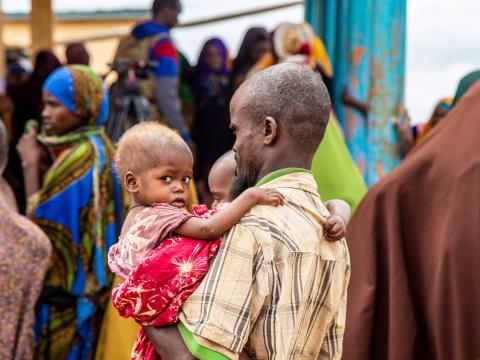Vulnerable children in Somalia could die waiting for help

One of the greatest burdens of being a humanitarian is witnessing children experiencing severe hunger and malnutrition suffer, then realising the situation will worsen before enough help arrives.
This is the reality facing millions of children in southern Somalia. More than 7 million people are experiencing severe food insecurity, 213,000 people are one step away from famine-like conditions.
Largely driven by the country’s worst drought in 40 years, hunger has displaced more than a million people, as of July 2022, who have no choice but to relocate. They’ve often walked for days or weeks because help can’t reach them if they stay behind.
I’ve met several of these displaced families in Doolow district, Kin, a mother of six, travelled from northern Somalia to escape drought and hunger. She’s now staying in a tiny shelter made of old clothes, plastic bags, and dry sticks with her children. Three are living with different disabilities.
Like most of the 18,000 others staying in this makeshift camp, she lost all of her livestock to the drought and came here with the hope of receiving assistance to survive. I cannot even begin to imagine how difficult her journey must have been. Kin also had to leave behind loved ones behind.
Now, families like hers survive on humanitarian aid, skipping meals for days or begging neighbours for food. That’s how the families I met celebrated the Eid-al-adha holidays in early July.
Everyone in Kin’s camp relies on a single tank that is filled twice a day by a water truck provided with the support of World Vision. This support is a lifeline. In camps that don’t have access to safe water, our frontline staff are witnessing a surge in waterborne diseases.
Some children won’t live to see the assistance if it doesn't arrive soon. Nearly 400,000 Somali children below five years old likely to be severely malnourished by the end of the year.
The desperate situation risks forcing parents to pull their children from school and prepare young girls for marriage to secure a dowry, just to survive the year. We've also met displaced girls who are forced to work to earn money to support their families. Even then, they can only afford one basic meal a day.
The scale of need and suffering is beyond anything I have seen. A local leader told me this drought is far worse than the one Somalia experienced in 2011, when 250,000 people died of hunger. Half were children.
Amidst the despair I have not lost hope.
Aid agencies like World Vision are on the ground, doing everything possible to help alleviate suffering. World Vision is reaching an estimated 459,000 people monthly (more than half of these children) with food, cash assistance, nutrition care, water provision and protection services. This helps cushion children and their families from the negative effects of the drought. But the fact is, we urgently need funding to nearly double the number of people who receive this critical support.
The international community must look at the needs of children holistically and fund interventions accordingly, including psychosocial support and education to cope with the effects of fleeing conflict and now drought. Somalia’s Humanitarian Response Plan has received less than 7 per cent of the required funding for education, and only 4 per cent for protection programmes.
I’ve met Somali children who are determined to build a better future for themselves and their country. They are the change we’ve been waiting for, but drought and hunger threaten to erode their dreams in an instant. The time to act is now.
Tobias Oloo is World Vision Somalia’s Operations Director
***Globally, World Vision is responding to the hunger crisis across 25 countries, this included seven in East Africa of which Somalia is among them. Learn more about and support World Vision's global response to a growing hunger crisis.